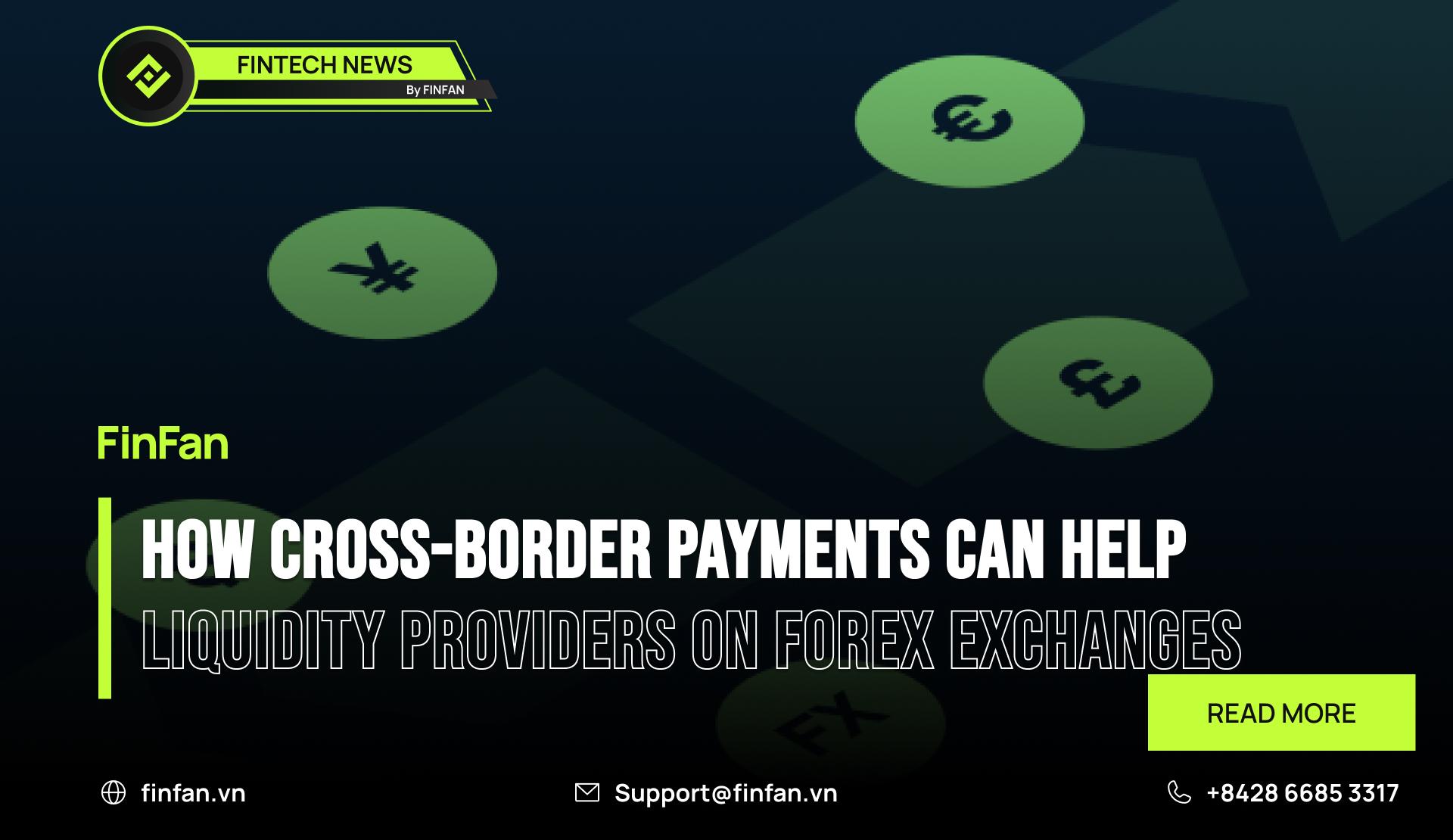How Cross-Border Payments Can Help Liquidity Providers on Forex Exchanges

In the fast-paced world of forex trading, liquidity providers (LPs) play a critical role in ensuring smooth and efficient market operations.
With the ever-increasing globalization of financial markets, cross-border payments have become a vital tool for LPs, offering numerous advantages that enhance their capabilities.
In this blog, we will explore how cross-border payments can help liquidity providers on forex exchanges.
The First Supporting of Cross-Border Payment Service Providers is Increasing Market Efficiency
Enhanced Market Depth:
Cross-border payments can introduce a more diverse range of participants from various regions, significantly increasing market depth. This influx of participants leads to more buy and sell orders, tighter spreads, and better liquidity. As a result, markets become more efficient, benefiting both traders and LPs.
Faster Transactions:
Modern cross-border payment systems, including blockchain-based solutions, enable near-instantaneous transfers. This speed reduces the time lag between order placements and execution, allowing LPs to respond quickly to market changes and maintain efficient operations.
The Second Supporting of Cross-Border Payment Service Providers is Accessing to Global Capital
Diverse Funding Sources:
LPs can access a broader range of funding sources through cross-border payments, including international investors and institutions. This access helps them maintain sufficient liquidity and respond effectively to market demands.
Currency Arbitrage Opportunities:
Cross-border payments enable LPs to engage in currency arbitrage by quickly moving funds across different markets to take advantage of price discrepancies. This flexibility enhances their profitability and market-making capabilities.
The Third Supporting of Cross-Border Payment Service Providers is Risk Management and Hedging
Currency Risk Management:
Efficient cross-border payments help LPs hedge against currency risk more effectively by facilitating quick and efficient transfers. This capability allows them to maintain stable operations despite market fluctuations.
Diversification:
LPs can diversify their currency holdings and exposure, reducing reliance on a single currency and mitigating the impact of adverse currency movements. This diversification is crucial for maintaining liquidity and stability in volatile markets.
The Fourth Supporting of Cross-Border Payment Service Providers is Cost Reduction
Lower Transaction Costs:
Modern cross-border payment solutions often come with lower fees compared to traditional banking methods. This reduction in transaction costs can significantly benefit LPs by improving their profitability and operational efficiency.
Reduced Operational Costs:
Automation and digitalization in cross-border payments streamline processes, cutting down on administrative and operational costs. This efficiency allows LPs to focus more on their core activities and less on managing transactions.
The Fifth Supporting of Cross-Border Payment Service Providers is Regulatory Compliance
Adherence to Local Regulations:
Cross-border payment providers often offer solutions that comply with local regulations, helping LPs navigate the complex regulatory landscape in different countries. This compliance ensures smooth and legal operations across borders.
Enhanced Reporting and Transparency:
Improved reporting mechanisms and transparency in cross-border payments assist LPs in meeting regulatory requirements and avoiding legal issues. This transparency is crucial for maintaining trust and reliability in the forex market.
The Sixth Supporting of Cross-Border Payment Service Providers is Enhanced Technology Integration
Blockchain and Digital Assets:
The integration of blockchain technology in cross-border payments offers secure, transparent, and immutable transaction records. This security enhances trust and reliability for LPs, making it easier for them to manage liquidity and execute trades.
API Integrations:
Modern cross-border payment platforms provide APIs that can seamlessly integrate with LPs’ existing systems. This integration facilitates smooth and efficient operations, allowing LPs to respond quickly to market demands and maintain liquidity.
Some Examples of the Connection between Cross-border Payment Service Providers and Liquidity Providers for Forex Exchanges
SWIFT gpi and Liquidity Providers
SWIFT gpi (Global Payments Innovation) enhances the speed, transparency, and traceability of cross-border payments. Liquidity providers can use SWIFT gpi to improve their forex trading operations:
Real-Time Tracking:
LPs can track cross-border payments in real time, providing better visibility and control over their funds.
Faster Payments:
Enhanced speed of cross-border transactions helps LPs execute trades more quickly and efficiently.
Transparency:
Improved transparency and detailed transaction information help LPs manage liquidity more effectively and comply with regulatory requirements.
TransferWise (Wise) and Liquidity Providers
TransferWise (now known as Wise) offers low-cost, efficient cross-border payment solutions. Liquidity providers can benefit from Wise’s innovative approach:
Low Fees:
Lower transaction costs improve the profitability of LPs.
Efficiency:
Wise’s efficient cross-border payment processes help LPs maintain liquidity and respond quickly to market changes.
Multi-Currency Accounts:
Wise offers multi-currency accounts, allowing LPs to hold and manage funds in different currencies, reducing currency risk.
Stellar Network and Liquidity Providers
The Stellar network is a blockchain-based platform that facilitates fast and low-cost cross-border payments. Liquidity providers can use Stellar’s capabilities to enhance their forex trading operations:
Decentralized Exchange:
Stellar’s decentralized exchange allows LPs to trade multiple currencies seamlessly, enhancing liquidity.
Low Transaction Costs:
Reduced fees help LPs maintain competitive spreads and improve profitability.
Speed:
Near-instantaneous transactions enable LPs to execute trades quickly and efficiently.
Payoneer and Liquidity Providers
Payoneer is a global payments platform that offers cross-border payment solutions to businesses and individuals. Liquidity providers can leverage Payoneer’s services to enhance their operations:
Global Reach:
Access to a wide network of international clients and partners helps LPs diversify their funding sources.
Efficiency:
Streamlined cross-border payment processes improve operational efficiency and liquidity management.
Compliance:
Payoneer’s compliance with local regulations helps LPs navigate the complex regulatory landscape of international forex trading.
Conclusion Regarding Cross-Border Payments and Liquidity Providers on Forex Exchanges
The advancements in cross-border payment technologies offer numerous benefits to liquidity providers on forex exchanges.
By leveraging these technologies, LPs can improve their operational efficiency, manage risks better, reduce costs, and enhance their ability to provide liquidity and maintain market stability.
As the global financial landscape continues to evolve, cross-border payments will undoubtedly play an increasingly vital role in supporting the operations of liquidity providers in the forex market.
This article was curated and authored by FinFan's market research and development team, alongside our marketing department.
About FinFan
FinFan is a cross-border embedded financial services company that focuses on mass disbursement, fund collection, card processing, IBAN, and digital APMs solutions, which can provide valuable input and integration on and for the same.
FinFan is already integrated with almost the world's well-known MTOs, PSPs, switch, and core fintech platforms such as Money Gram, Thunes, Qiwi, Remitly, World Remit, Bancore, PaySend, Terrapay, Ria Money Transfer (Euronet), Dlocal, Ripple, TripleA, FoMo Pay, Wings, etc.
For more information, please get in touch with us through:
🌐https://finfan.io
📞(+84) 2866 85 3317
✉ support@finfan.vn
LinkedIn: FinFan





